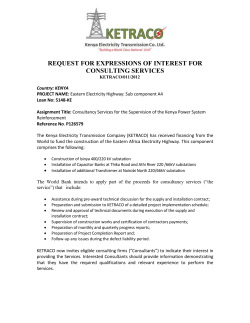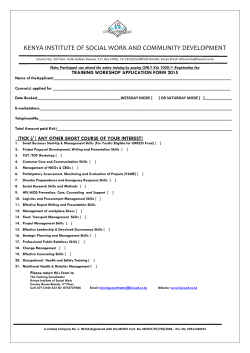
PRO-POOR ACCESS TO GREEN ELECTRICITY IN KENYA
PRO-POOR ACCESS TO GREEN ELECTRICITY IN KENYA Pro-Poor Electricity Provision Ana Pueyo May 2015 The IDS programme on Strengthening Evidence-based Policy works across seven key themes. Each theme works with partner institutions to co-construct policy-relevant knowledge and engage in policy-influencing processes. This material has been developed under the Pro-Poor Electricity Provision theme. Special thanks to Rachel Godfrey-Woods for her review and suggestions. The material has been funded by UK aid from the UK Government, however the views expressed do not necessarily reflect the UK Government’s official policies. AG Level 2 Output ID: 136 PRO-POOR ACCESS TO GREEN ELECTRICITY IN KENYA Ana Pueyo May 2015 This is an Open Access publication distributed under the terms of the Creative Commons Attribution License, which permits unrestricted use, distribution, and reproduction in any medium, provided the original author and source are clearly credited. First published by the Institute of Development Studies in May 2015 © Institute of Development Studies 2015 IDS is a charitable company limited by guarantee and registered in England (No. 877338). Is Kenya on the road to achieving an electricity system which is both green and pro-poor? What are the main challenges to pursuing this goal? The two questions guiding this study are particularly relevant in a country with exceptional renewable energy resources, where 80 per cent of the population lacks access to electricity and 50 per cent lives in poverty. What is pro-poor access to electricity? Pro-poor access to electricity is access that provides poor people with energy services enabling poverty reduction. These services include, for example: light, information and communications technologies, mechanical power for productive uses, and refrigeration or water pumping. Their poverty impacts may consist of income generation, female empowerment, or better education and health. To enable these impacts, electricity needs to be consumed at a sufficient level by the poor and provided with reliability and quality. Access to electricity can be considered pro-poor in its weak form when it results in absolute increases in its use and in outcomes for the poor, regardless of how access improves for the non-poor. In a strong form, pro-poor access requires that availability, use and outcomes of electricity increase further for the poor than for wealthier groups, so that inequality in access to electricity also falls. How can it be achieved? The poverty effects of the supply of electricity are not automatic, however, and a number of intermediate goals need to be achieved for benefits to occur. Firstly, once electricity is generated, grid-connected generation needs to be reliably fed into the system and off-grid solutions need to provide a durable and sufficient level of access to electricity. Secondly, this additional supply must be made accessible and affordable for the poor. With on-grid energy, this is a matter of extending the grid to areas with high poverty incidence, ensuring the quality and reliability of supply and setting connection costs and consumption tariffs which are affordable for the poor. For off-grid energy, it is a question of situating the generating capacity in areas of high poverty incidence, using business models that make upfront costs affordable for the poor and ensuring durability of the generation technology. Thirdly, electricity needs to be used at a sufficient level and for a diversity of activities, crucially including income generation activities, if it is to translate into poverty reduction. Fourthly and finally, increased electricity supply can also indirectly reduce poverty by boosting economic growth provided that redistribution mechanisms are in place which allow the poor to benefit from this growth. What are the main challenges for Kenya to follow a pro-poor, green electrification strategy? An analysis of electrification and poverty rates and geography in Kenya, financial sustainability of green electricity and affordability delivers two main conclusions: 1. Without an explicitly pro-poor electrification strategy, Kenya’s poor will be left behind The large gap between poverty levels and electrification rates in Kenya points at a significant supressed demand: 93 per cent of the rural population has not got access to electricity, but ‘only’ 50 per cent is below the poverty line. Thus a large share of the rural population would be able to afford grid electricity tariffs at their current level. Private developers of off-grid alternatives are also finding willingness to pay for higher tariffs, and while excessive connection costs are a major hurdle to grid connections, these could be addressed with finance plans like the recently piloted ‘stima loan’. The Government of Kenya (GoK) does not have an explicit mandate to target the poorest first and private investors naturally look for the most profitable ventures. Therefore, centralised 1 and decentralised electrification strategies in Kenya are likely to target those people living in dense settlements close to the existing grid and where poverty levels are lower than lack of access. Besides, a large share of public investments focuses on guaranteeing supply for commercial and industrial users in order to achieve ambitious economic growth targets. Consequently, a strong or even a weak form of pro-poor electrification is not likely to happen in Kenya without further public intervention. Interventions that try to reach the poor through subsidies on final consumption or capital costs risk crowding out much needed private investment and benefiting the better off. However, acknowledging the importance of equitable access to energy requires public funders to focus on the worse-off, who would not be able to afford a minimum level of consumption otherwise. 2. High costs of finance compromise affordability for the poor The high cost of equity (close to 20 per cent) and debt (around 10 per cent) for renewable energy projects in Kenya as compared to international benchmarks reflect investors’ high perceived risks. Providing financiers with their required rates involves charging expensive tariffs, which damages affordability. To protect consumers from excessive prices, the government has set a pricing cap for all grid-connected plants. The cap is considered too low for many wind, biomass and especially solar projects. This means that for these technologies, only those projects located in sites with exceptional resources are commercially viable. Additionally, for rural connections to the grid to be financially sustainable there needs to be a sufficient level of household demand as well as enough connection requests to pay for distribution lines. These conditions are often not met. Decentralised supply does not enjoy much government support but on the other hand is not subject to tariff caps. Given the large suppressed demand in rural areas, project developers are finding willingness to pay the high prices of electricity that are compatible with a 20 per cent return on equity (RoE). While this solves the problem of lack of access for those who can pay, it is not a solution for pro-poor provision. Which policies could address these challenges? A two-tiered approach to electrification in Kenya could be followed consisting of a large offgrid programme to cover the basic lighting needs of the rural poor and a grid intensification strategy for the urban poor, while more ambitious, market-based, electrification efforts that allow for productive uses are continued in parallel. The most challenging aspects of this approach are tracking the most vulnerable that require support while avoiding rent seeking or crowding out of the private sector. Previous experiences in reaching the most vulnerable with social protection, mainly cash transfer programmes, could be highly valuable to address these challenges, but Kenya’s cash transfer programmes are still mainly in their early stages. The issue of large financing costs which are incompatible with affordability can be addressed in three ways. Firstly, by directly addressing the risks which are the root-cause of those high costs. These include deficient power purchase agreement (PPA) procurement processes, a lack of clear and credible regulations for decentralised small power producers, an unstable feed-in tariff (FiT) policy, weaknesses in grid management, risk of non-payment by the national utility, and bottlenecks in the financial sector or political risks. Secondly, for those risks that are difficult to mitigate with policy, financial de-risking instruments like guarantees or political risk insurance can be used to transfer investors’ risks to public actors such as development banks. Finally, and in line with the proposed two-tiered approach, impact investors and donors willing to accept lower than market RoE could address the least advantaged segments of the population. 2
© Copyright 2025









